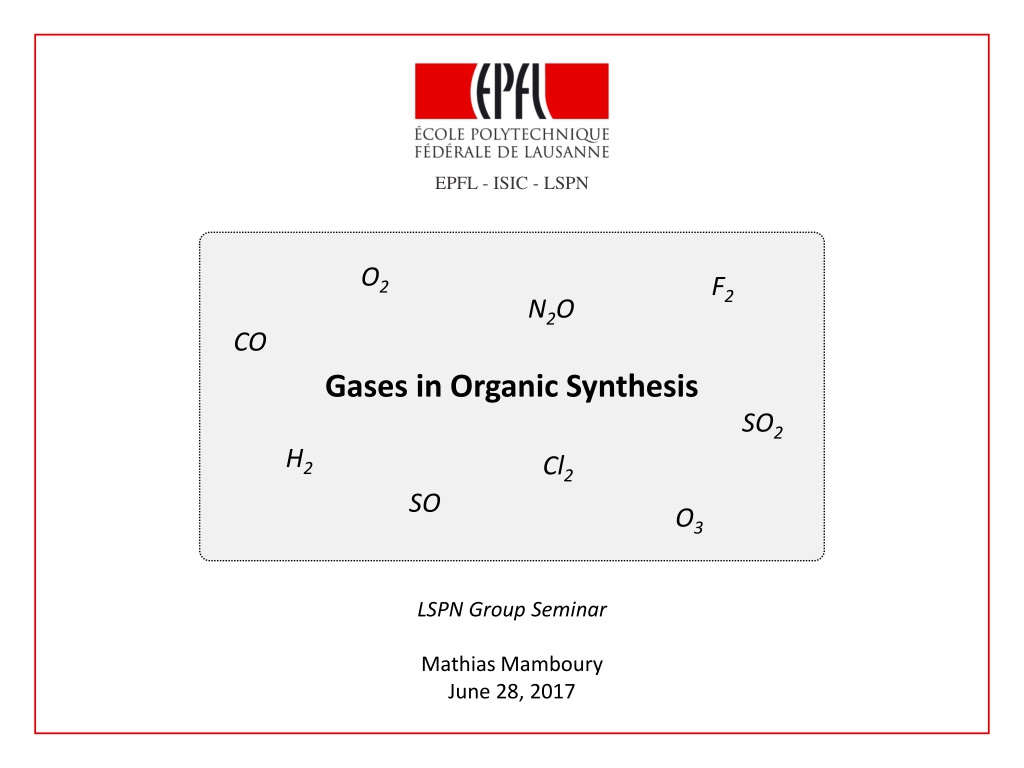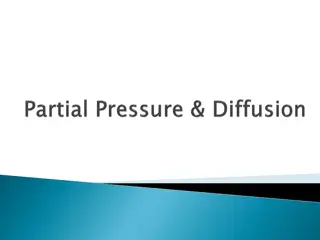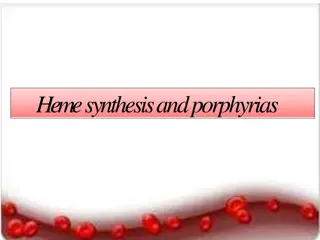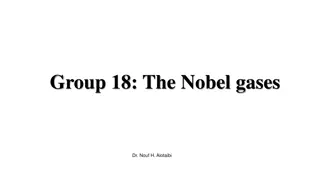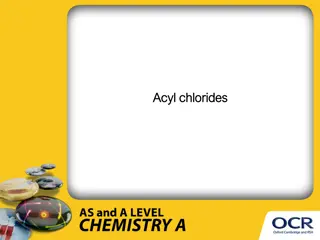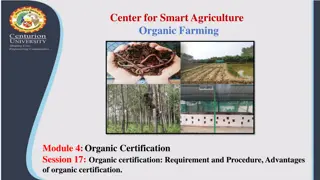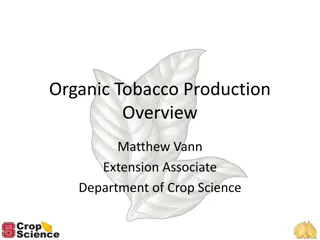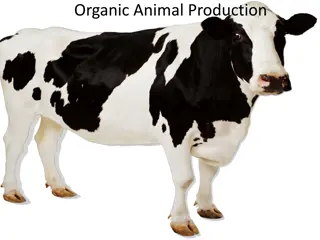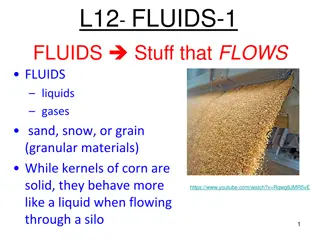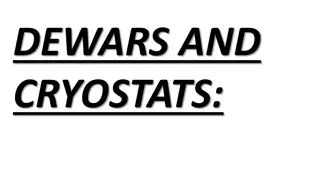Role of Gases in Organic Synthesis: A Comprehensive Overview
The presentation delves into the significance of gases in organic synthesis at standard temperature and pressure, focusing on reactions with atom incorporation for the synthesis of useful organic molecules. It covers various gases such as H2, O2, O3, CO, NO, N2O, SO2, Cl2, F2, discussing their advantages, disadvantages, and applications in synthetic chemistry. The discussion includes pioneering works, reactive species, and reactions involving singlet oxygen in organic transformations.
Download Presentation

Please find below an Image/Link to download the presentation.
The content on the website is provided AS IS for your information and personal use only. It may not be sold, licensed, or shared on other websites without obtaining consent from the author. Download presentation by click this link. If you encounter any issues during the download, it is possible that the publisher has removed the file from their server.
E N D
Presentation Transcript
EPFL - ISIC - LSPN O2 F2 N2O CO Gases in Organic Synthesis SO2 H2 Cl2 SO O3 LSPN Group Seminar Mathias Mamboury June 28, 2017
Table of contents 1) Introduction 2) H2 Paul Dyson 3) O2/ O3 4) CO / CO2 Kay Severin 5) NO / NO2/ N2O 6) SH2/ SO2 Pierre Vogel 7) F2/ Cl2 8) Conclusion 2 Mathias Mamboury LSPN Group Seminar June 28, 2017
1) Introduction Scope of this presentation : Gases at Standard Temperature and Pressure (STP = 0 C, 1 atm) Only reactions with incorporation of atoms Focus on the synthesis of usefull organic molecules Not covered : common reactions (hydrogenation, ozonolysis, ) and hydrocarbons (CH4, ethylene, ) Gases as synthons : Advantages Disadvantages Cheap (price per mol) Not easy to handle No by-products in most cases Toxic (few exceptions) Atom-economic Control of stoechiometry 3 Mathias Mamboury LSPN Group Seminar June 28, 2017
2) H2 Hydrogen: H2 Most used gas in synthetic chemistry? Reduction of bonds with metal catalysts : C=C, C=O, C-X, N-N, NO2, etc. 1938 : First homogeneous catalytic hydrogenation (Halpern) : Hydroformylation (Roelen) : Hydrogenation nowadays : Ability to reduce almost any unsaturated functional group. etc. Early transition metals. Applications for energy and environment ? Chemo-, diastereo- and enantioselectivity. Prof. Michael Krische s chemistry (see my previous seminar) Wilt, J. C.; Collier, S. J. In Encyclopedia of Reagents for Organic Synthesis; John Wiley & Sons, Ltd, 2001. Trans. Faraday Soc. 1938, 34, 1181-1191 DE Patent 849 548 (1938) 4 Mathias Mamboury LSPN Group Seminar June 28, 2017
3) O2/ O3 Oxygen : O2 Reactive species : singlet oxygen1O2 Lifetime : 2-1000 s depending on the solvent Photosensitized generation of 1O2with dyes : triplet state singlet state = dye Wasserman, H. H.; DeSimone, R. W.; Chia, K. R. X.; Banwell, M. G. In EROS; John Wiley & Sons, Ltd, 2001. Triplet and singlet states : https://en.wikipedia.org/wiki/Singlet_oxygen (June 24, 2017) Sensitization : https://www.picoquant.com/applications/category/life-science/singlet-oxygen (June 24, 2017) 5 Mathias Mamboury LSPN Group Seminar June 28, 2017
3) O2/ O3 Singlet oxygen ene reaction (Schenck reaction) : 1,2-Cycloadditions : Schenck, G. O.; Schulte-Elte, K.-H. Justus Liebigs Ann. Chem. 1958, 618 (1), 185 193. Foote, C. S.; Lin, J. W.-P. Tetrahedron Letters1968, 9 (29), 3267 3270. Jefford, C. W.; Barchietto, G. TetrahedronLetters1977, 18 (51), 4531 4534. 6 Mathias Mamboury LSPN Group Seminar June 28, 2017
3) O2/ O3 1,4-Cycloadditions : -Hydroxylation : Schenck, G. O. Angewandte Chemie 1952, 64 (1), 12 23. Meyers, A. I.; Nolen, R. L.; Collington, E. W.; Narwid, T. A.; Strickland, R. C. J. Org. Chem.1973, 38 (11), 1974 1982. Foote, C. S.; Mazur, S.; Burns, P. A.; Lerdal, D. J. Am. Chem. Soc. 1973, 95 (2), 586 588. Chaudhari, M. B.; Sutar, Y.; Malpathak, S.; Hazra, A.; Gnanaprakasam, B. Org. Lett.2017. (ASAP) 7 Mathias Mamboury LSPN Group Seminar June 28, 2017
3) O2/ O3 Ozone : O3 Generated from O2with electrodes (concentration in O3~ 3-4%) Well know application : ozonolysis of alkenes Epoxidation of hindered alkenes : Ozonation of alkynes : Berglund, R. A.; Kreilein, M. M. In EROS; John Wiley & Sons, Ltd, 2001. Hochstetler, A. R. J. Org. Chem. 1975, 40 (11), 1536 1541. Yang, N.-C. C.; Libman, J. J. Org. Chem. 1974, 39 (12), 1782 1784. 8 Mathias Mamboury LSPN Group Seminar June 28, 2017
4) CO / CO2 Carbon monoxide: CO Odorless and poisonous Well known applications : hydroformylation , metal-catalyzed CO insertions, Pausand-Khand Trapping with organolithiums : Trapping with radicals : Chatani, N.; Murai, S.; Fukuyama, T.; Ryu, I. In EROS; John Wiley & Sons, Ltd, 2001. Murai, S.; Ryu, I.; Iriguchi, J.; Sonoda, N. J. Am. Chem. Soc. 1984, 106 (8), 2440 2442. Ryu, I.; Kusano, K.; Ogawa, A.; Kambe, N.; Sonoda, N. J. Am. Chem. Soc. 1990, 112 (3), 1295 1297. Ryu, I.; Kusano, K.; Masumi, N.; Yamazaki, H.; Ogawa, A.; Sonoda, N. TetrahedronLetters1990, 31 (47), 6887 6890. 9 Mathias Mamboury LSPN Group Seminar June 28, 2017
4) CO / CO2 Carbon dioxide : CO2 Product of combustion / Greenhouse gas Reaction with phenoxydes (Kolbe-Schmidt) : Trapping with organolithiums (numerous examples!): Mander, L. N.; Andreatta, J. R.; Darensbourg, D. J. In EROS; John Wiley & Sons, Ltd, 2001. 10 Mathias Mamboury LSPN Group Seminar June 28, 2017
4) CO / CO2 Trapping with enolates (numerous examples!) : NHC catalyzed reactions (Felix & Paul Dyson) : Horikawa, M.; Tateda, K.; Tuzuki, E.; Ishii, Y.; Ueda, C.; Takabatake, T.; Miyairi, S.; Yamaguchi, K.; Ishiguro, M. Bioog. Med. Chem. Lett. 2006, 16 (8), 2130 2133. Bobbink, F. D.; Das, S.; Dyson, P. J. Nat. Protocols2017, 12 (2), 417 428. Bobbink, F. D.; Gruszka, W.; Hulla, M.; Das, S.; Dyson, P. J. Chem. Commun.2016, 52 (71), 10787 10790. 11 Mathias Mamboury LSPN Group Seminar June 28, 2017
4) CO / CO2 Ruben Martin : For more examples, see : http://www.iciq.org/research/research_group/prof-ruben-martin/section/publications/ Liu, Y.; Cornella, J.; Martin, R. J. Am. Chem. Soc. 2014, 136 (32), 11212 11215. Wang, X.; Nakajima, M.; Martin, R. J. Am. Chem. Soc. 2015, 137 (28), 8924 8927. van Gemmeren, M.; B rjesson, M.; Tortajada, A.; Sun, S.-Z.; Okura, K.; Martin, R. Angew. Chem. Int. Ed. 2017, 56 (23), 6558 6562. 12 Mathias Mamboury LSPN Group Seminar June 28, 2017
5) NO / NO2/ N2O Nitric oxide : NO Persistent free radical 2 NO + O2 2 NO2 Synthesis of oximes : Navuluri, C. S. In EROS; John Wiley & Sons, Ltd, 2001. Okamoto, T.; Kobayashi, K.; Oka, S.; Tanimoto, S. J. Org. Chem. 1987, 52 (23), 5089 5092. de Salas, C.; Blank, O.; Heinrich, M. R. Chem. Eur. J. 2011, 17 (34), 9306 9310. 13 Mathias Mamboury LSPN Group Seminar June 28, 2017
5) NO / NO2/ N2O Nitrogen dioxide : NO2 In equilibrium with N2O4below 135 C Nitration of aromatics and double bonds : Nitration with HNO3would afford NO2as nitro source and oxidant : Popik, V. V. In EROS; John Wiley & Sons, Ltd, 2001. Li, X.; Zhuang, S.; Fang, X.; Liu, P.; Sun, P. Org. Biomol. Chem. 2017, 15 (8), 1821 1827. 14 Mathias Mamboury LSPN Group Seminar June 28, 2017
5) NO / NO2/ N2O Nitrous oxide : N2O Anesthetic / drug (laughing gas) Epoxidation : 1,3-Cycloaddition : Severin, K. Chem. Soc. Rev.2015, 44 (17), 6375 6386. Tanaka, H.; Hashimoto, K.; Suzuki, K.; Kitaichi, Y.; Sato, M.; Ikeno, T.; Yamada, T. BCSJ 2004, 77 (10), 1905 1914. Banert, K.; Plefka, O. Angew. Chem. Int. Ed. 2011, 50 (27), 6171 6174. 15 Mathias Mamboury LSPN Group Seminar June 28, 2017
5) NO / NO2/ N2O Reactions with nucleophiles : Reactions with Grignard reagents (Kay Severin) : Koga, G.; Anselme, J.-P. Chem. Commun. (London) 1968, No. 8, 446 447. Tskhovrebov, A. G.; Solari, E.; Scopelliti, R.; Severin, K. Organometallics 2014, 33 (10), 2405 2408. Kiefer, G.; Riedel, T.; Dyson, P. J.; Scopelliti, R.; Severin, K. Angew. Chem. Int. Ed. 2015, 54 (1), 302 305. 16 Mathias Mamboury LSPN Group Seminar June 28, 2017
6) SH2/ SO2 Hydrogensulfide : SH2 Toxic and malodorant Synthesis of thioketones : Synthesis of thiophenes : Dittmer, D. C. In EROS; John Wiley & Sons, Ltd, 2001. Le Nocher, A.-M.; Metzner, P. TetrahedronLetters1992, 33 (41), 6151 6154. Cook, S.; Henderson, D.; Richardson, K. A.; Taylor, R. J. K.; Saunders, J.; Strange, P. G. J. Chem. Soc., Perkin Trans. 11987, No. 0, 1825 1831. 17 Mathias Mamboury LSPN Group Seminar June 28, 2017
6) SH2/ SO2 Sulfur dioxide : SO2 Boiling point : -10 C Versatile reactivity Addition of organometallics (numerous examples!) : Reaction with an enolate : Burke, S. D. In EROS; John Wiley & Sons, Ltd, 2001. Deeming, A. S.; Emmett, E. J.; Richards-Taylor, C. S.; Willis, M. C. Synthesis2014, 46 (20), 2701 2710. (Review) Marvel, C. S.; Johnson, R. S. J. Org. Chem.1948, 13 (6), 822 829. Singh, N. P.; Biellmann, J.-F., Synth. Commun. 1988, 18, 1061 18 Mathias Mamboury LSPN Group Seminar June 28, 2017
6) SH2/ SO2 Pericyclic reactions : Bora-ene reaction (Pierre Vogel) : Vogel, P.; Turks, M.; Bouchez, L.; Markovi , D.; Varela- lvarez, A.; Sordo, J. . Acc. Chem. Res. 2007, 40 (10), 931 942. (Review) Turks, M.; Lawrence, A. K.; Vogel, P. TetrahedronLetters2006, 47 (16), 2783 2786. Markovi , D.; Volla, C. M. R.; Vogel, P.; Varela- lvarez, A.; Sordo, J. A. Chem. Eur. J. 2010, 16 (20), 5969 5975. 19 Mathias Mamboury LSPN Group Seminar June 28, 2017
7) F2/ Cl2 Fluorine : F2 Strong oxidant Able to fluorinate simple alkanes ! Traditional reactivity as X2: Works with diketones, malonates, -ketoesters, etc. Good combination of substituents requiredto avoid double fluorination and reach high regioselectivity ! Kotun, S. P. In EROS; John Wiley & Sons, Ltd, 2001. Sandford, G. Journal of Fluorine Chemistry2007, 128 (2), 90 104. (Review) Bumgardner, C. L.; Sloop, J. C. J. Fluorine Chem. 1992, 56 (2), 141 146. Vints, I.; Rozen, S. Tetrahedron2016, 72 (5), 632 636. Chambers, R. D.; Hutchinson, J.; Sparrowhawk, M. E.; Sandford, G.; Moilliet, J. S.; Thomson, J. J. Fluorine Chem.2000, 102 (1), 169 173. 20 Mathias Mamboury LSPN Group Seminar June 28, 2017
7) F2/ Cl2 Substitution of halogens at stabilized carbocations : Controlled substitution of tertiary unactivated hydrogens : - F2acts as electrophile at the most electron-rich C-H bond. - Longer reaction time or higher temperature: multiple fluorination ! Rozen, S.; Brand, M. J. Org. Chem. 1981, 46 (4), 733 736. Rozen, S.; Gal, C.; Faust, Y. J. Am. Chem. Soc.1980, 102 (22), 6860 6861. 21 Mathias Mamboury LSPN Group Seminar June 28, 2017
7) F2/ Cl2 Chlorine : Cl2 Widely used in industry to make CH2Cl2, CHCl3, etc. Laboratory : mosly used as oxidant / fewer chlorination reactions Traditional reactivity as X2: Aromatics : polychlorination et regioselectivity issues ! Cornel, V. In EROS; John Wiley & Sons, Ltd, 2001. 22 Mathias Mamboury LSPN Group Seminar June 28, 2017
8) Conclusion Gases as synthons : Advantages Cheap (price per mol) No by-products in most cases Atom-economic Unique transformations Usefull products Thank you for your attention ! Questions / discussion ? 23 Mathias Mamboury LSPN Group Seminar June 28, 2017
